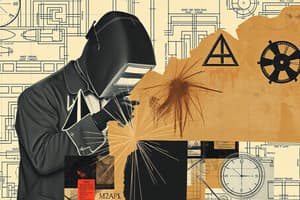Podcast
Questions and Answers
Materials verification is essential for structural integrity of fabricated products.
Materials verification is essential for structural integrity of fabricated products.
True (A)
Which type of blueprint shows the detailed information about welding of components to combine into a larger component?
Which type of blueprint shows the detailed information about welding of components to combine into a larger component?
- Details
- Fabricated Parts (correct)
- Assembly Drawings
Why are clear and accurate welding blueprints important for production efficiency?
Why are clear and accurate welding blueprints important for production efficiency?
Clear and accurate drawings minimize errors during fabrication and accelerate production timelines.
Inaccurate blueprints can lead to structural failure, safety hazards, and ______ rework.
Inaccurate blueprints can lead to structural failure, safety hazards, and ______ rework.
Match the following types of welding blueprints with their corresponding descriptions:
Match the following types of welding blueprints with their corresponding descriptions:
Welding blueprints are only relevant to the fabrication process, not the construction process.
Welding blueprints are only relevant to the fabrication process, not the construction process.
What is the primary reason for adhering to welding codes while following the procedures outlined in the blueprint?
What is the primary reason for adhering to welding codes while following the procedures outlined in the blueprint?
Explain how accurate blueprints contribute to cost savings in welding projects.
Explain how accurate blueprints contribute to cost savings in welding projects.
Which of the following is NOT a crucial aspect of a welding blueprint?
Which of the following is NOT a crucial aspect of a welding blueprint?
A comprehensive understanding of ______ is necessary for successful welding projects.
A comprehensive understanding of ______ is necessary for successful welding projects.
Welding blueprints may include specific welding procedure specifications (WPS) or welding parameters.
Welding blueprints may include specific welding procedure specifications (WPS) or welding parameters.
Interpretation and application of information in a welding blueprint is crucial for safe fabrication processes that adhere to regulations.
Interpretation and application of information in a welding blueprint is crucial for safe fabrication processes that adhere to regulations.
What types of symbols are used to represent different weld types on a welding blueprint?
What types of symbols are used to represent different weld types on a welding blueprint?
Welding blueprints define the [BLANK] required for a project.
Welding blueprints define the [BLANK] required for a project.
Match the following welding process indicators with their corresponding welding processes:
Match the following welding process indicators with their corresponding welding processes:
What is the primary importance of understanding welding symbols on a blueprint?
What is the primary importance of understanding welding symbols on a blueprint?
Tolerances on a welding blueprint indicate the minimum acceptable size for welds.
Tolerances on a welding blueprint indicate the minimum acceptable size for welds.
What is the role of material specifications in a welding blueprint?
What is the role of material specifications in a welding blueprint?
Understanding welding blueprints requires [BLANK] and knowledge of welding standards.
Understanding welding blueprints requires [BLANK] and knowledge of welding standards.
Which of the following is NOT a common type of weldment symbol found on a welding blueprint?
Which of the following is NOT a common type of weldment symbol found on a welding blueprint?
Flashcards
Welding Blueprints
Welding Blueprints
Detailed drawings specifying welding procedures, materials, and dimensions.
Welding Symbols
Welding Symbols
Standardized symbols that indicate the type of weld and procedure used.
Material Specifications
Material Specifications
Details listing the chemical composition and thickness of materials used.
Dimensions
Dimensions
Signup and view all the flashcards
Welding Procedures
Welding Procedures
Signup and view all the flashcards
Tolerances
Tolerances
Signup and view all the flashcards
Finish Requirements
Finish Requirements
Signup and view all the flashcards
Welding Process Indicators
Welding Process Indicators
Signup and view all the flashcards
Interpreting Welding Blueprints
Interpreting Welding Blueprints
Signup and view all the flashcards
Procedure Qualification Records (PQRs)
Procedure Qualification Records (PQRs)
Signup and view all the flashcards
Materials Verification
Materials Verification
Signup and view all the flashcards
Quality Control
Quality Control
Signup and view all the flashcards
Fabricated Parts
Fabricated Parts
Signup and view all the flashcards
Assembly Drawings
Assembly Drawings
Signup and view all the flashcards
Details in Welding
Details in Welding
Signup and view all the flashcards
Structural Integrity
Structural Integrity
Signup and view all the flashcards
Production Efficiency
Production Efficiency
Signup and view all the flashcards
Cost Savings
Cost Savings
Signup and view all the flashcards
Safety in Welding
Safety in Welding
Signup and view all the flashcards
Importance of Accuracy
Importance of Accuracy
Signup and view all the flashcards
Study Notes
Introduction to Welding Blueprints
- Welding blueprints, like other engineering drawings, provide detailed instructions for fabricating and assembling components.
- They precisely define the welding procedures, material specifications, and tolerances required for a project.
- These blueprints are crucial for quality control, cost estimation, and efficient production.
- Blueprints often include symbols, dimensions, and annotations specific to welding processes.
Essential Components of a Welding Blueprint
- Welding Symbols: Standardized symbols represent the type of weld, weldment, and welding procedure to be used.
- Materials: Blueprint may list details like part material specifications, including specific chemical compositions and thicknesses.
- Dimensions: Precise dimensions for all welded pieces are represented on the blueprint. These show critical measurements and tolerances.
- Welding Procedures: Some blueprints include specific welding procedure specifications (WPS) or welding parameters. Often codes like ASME and AWS are referenced.
- Tolerances: Allowable deviations or variations in dimensions and weld sizes are documented for each piece.
- Finish Requirements: The blueprint may specify the finish required on the weld or the overall component. This may include, for example, deburring or grinding requirements.
Common Welding Symbols
- Weld Symbols: Different symbols represent different weld types (e.g., fillet, groove, plug, spot).
- Welding Process Indicators: Symbols indicate the specific welding process (e.g., SMAW, GMAW, GTAW).
- Weldment Symbols: Symbols specifying weldments, such as lap joints, butt joints, corner joints.
- Welding Procedure Specifications (WPS) and Procedure Qualification Records (PQRs): References to, or inclusion of, the WPS numbers for the different welds are often included. This helps control weld quality.
- Material Designations and Specifications: Material specifications including the material designation and related codes.
Interpreting Welding Blueprints
- Skill and Practice: Reading and understanding welding blueprints requires practice and knowledge of welding standards.
- Understanding Welding Symbols: Accurate interpretation depends primarily on identifying the symbols with high precision.
- Following Dimensions: Precise measurements based on the drawings are essential for successful fabrication.
- Materials Verification: Matching material specifications on the blueprint to the actual materials used is critical to ensuring structural integrity.
- Quality Control: Implementing and closely following the procedures outlined in the blueprint is paramount for quality control and safety of the finished product. Adherence to welding codes is essential.
Types of Welding Blueprints
- Fabricated Parts: These blueprints display detailed information about welding of components to combine into a larger component.
- Assembly Drawings: These blueprints demonstrate the configuration and location of welds between different components of a structure.
- Details: Close-up views of specific welded joints to provide more intricate details about the critical parameters and techniques of the weld.
Importance of Accuracy in Welding Blueprints
- Structural Integrity: Inaccurate blueprints can lead to structural failure, safety hazards, and costly rework.
- Production Efficiency: Clear and accurate drawings minimize errors during fabrication and accelerate production timelines.
- Cost Savings: By eliminating errors and unnecessary rework, these blueprints help minimize operational costs and delays.
- Safety: Accurate blueprints assist in safe fabrication processes that adhere to regulations.
Conclusion
- Welding blueprints are critical documents in fabrication and construction.
- Each detail is critical for high-quality and safe operation and a comprehensive understanding is necessary.
- Carefully interpreting and applying the information contained within the blueprint is paramount.
Studying That Suits You
Use AI to generate personalized quizzes and flashcards to suit your learning preferences.




